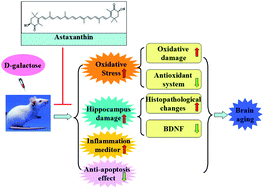Astaxanthin alleviates brain aging in rats by attenuating oxidative stress and increasing BDNF levels
Abstract
Astaxanthin (AST) is a carotenoid pigment which possesses potent antioxidative, anti-inflammatory, and neuroprotective properties. The aim of this study was to investigate whether administration of AST had protective effects on D-galactose-induced brain aging in rats, and further examined its protective mechanisms. The results showed that AST treatment significantly restored the activities of glutathione peroxidase (GSH-PX) and superoxide dismutase (SOD), and increased glutathione (GSH) contents and total antioxidant capacity (T-AOC), but decreased malondialdehyde (MDA), protein carbonylation and 8-hydroxy-2- deoxyguanosine (8-OHdG) levels in the brains of aging rats. Furthermore, AST increased the ratio of Bcl-2/Bax, but decreased the expression of Cyclooxygenase-2 (COX-2) in the brains of aging rats. Additionally, AST ameliorated histopathological changes in the hippocampus and restored brain derived neurotrophic factor (BDNF) levels in both the brains and hippocampus of aging rats. These results suggested that AST could alleviate brain aging, which may be due to attenuating oxidative stress, ameliorating hippocampus damage, and upregulating BDNF expression.


 Please wait while we load your content...
Please wait while we load your content...